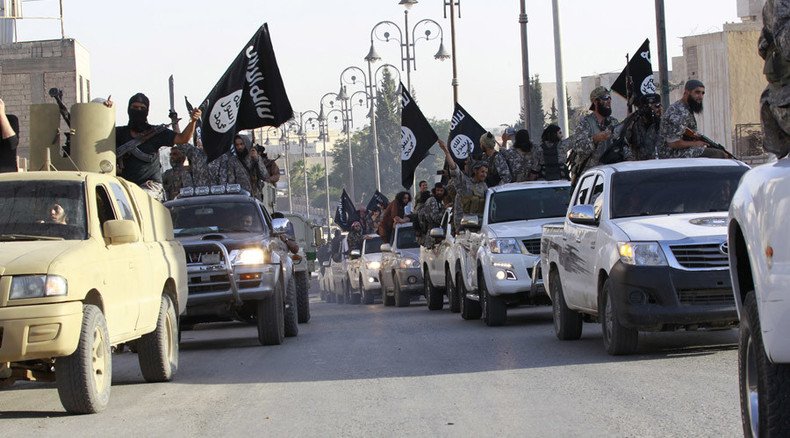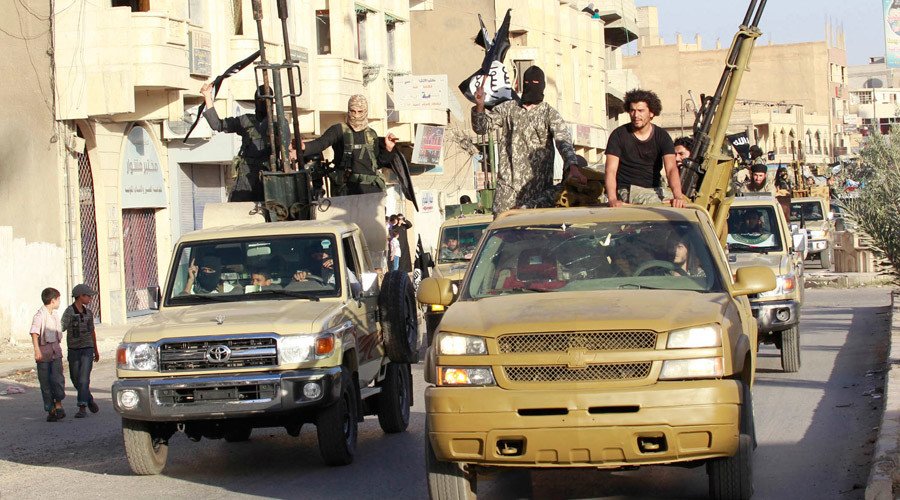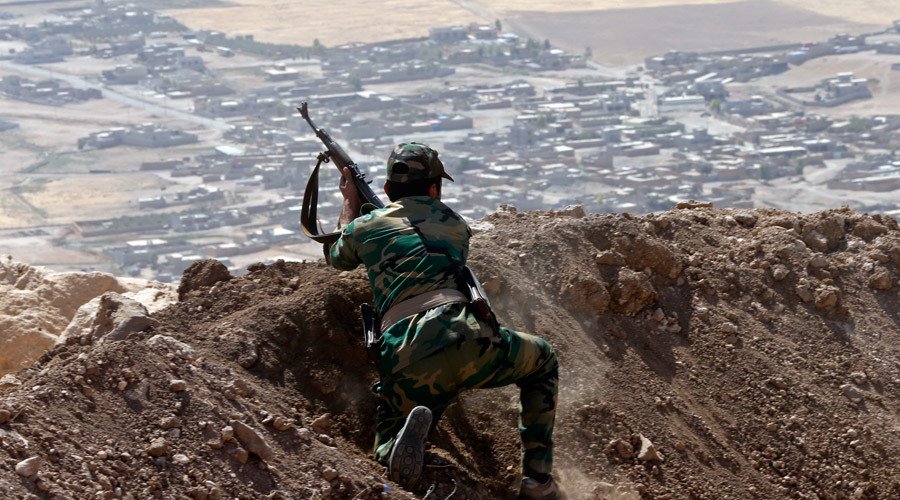Saddam-era veterans account for ISIS battlefield victories, dominate group's top command - report

Islamic State's top brass has been hugely dominated by former officers from Saddam Hussein's military, spy agencies and senior intelligence officials, including the chief of a key counterterrorism intelligence unit, according to a new report.
The experience they bring is said to be a major reason for Islamic State (IS, formerly ISIS/ISIL) victories in conquering large parts of Iraq and Syria, senior Iraqi officers on the front lines of the fight against IS told AP. Former Hussein officers gave the militant group the structuring and discipline it needed to bring together jihadist fighters from across the world. They have been allegedly put in charge of intelligence-gathering, spying on the Iraqi forces, maintaining and upgrading weapons, as well as trying to develop a chemical weapons program.
The officials estimate the number of Saddam-era veterans in mid- and senior-level positions within IS ranks stands between 100 and 160. They hail from Sunni-dominated areas as a rule, with intelligence officers mostly from western Anbar province, the majority of army officers from the northern Iraqi city of Mosul and members of security services exclusively from Saddam's clan around his hometown of Tikrit, a veteran of battles against IS north and west of Baghdad, Brigadier General Abdul-Wahhab al-Saadi, told AP.
A former CIA case officer who has served in Iraq, Patrick Skinner, told AP that Saddam-era military and intelligence officers were a "necessary ingredient" in IS' battlefield triumphs last year, accounting for its expansion from a "terrorist organization to a proto-state."
"Their military successes last year were not terrorist, they were military successes," said Skinner, who currently works for a private strategic intelligence services firm.
Another aspect of the problem is how officers from Saddam's mainly secular regime happened to infuse one of the world's most radical Islamic extremist groups. It's believed that a Saddam-era program which tolerated Islamic hard-liners in the military in the 1990s, as well as anger among Sunni officers when the Pentagon disbanded Saddam's military in 2003 have mostly contributed to the transformation in Islamic State’s present line-up.

The group's second-in-command, al-Baghdadi's deputy, is a former Saddam-era army major, Saud Mohsen Hassan, who, according to the intelligence chief who spoke with AP on condition of anonymity, goes by the pseudonyms Abu Mutazz and Abu Muslim al-Turkmani. Hassan is also known as Fadel al-Hayali, a fake name he used before the fall of Saddam, the intelligence chief said.
US-run Bucca prison camp as incubator for IS
During the 2000s, Hassan was imprisoned in the Bucca prison camp, where al-Baghdadi was also held. It's the main detention center for members of the Sunni insurgency, maintained by the US near the Umm Qasr port city, in southern Iraq. The prison became a kind of hatchery for the Islamic State group, bringing militants like al-Baghdadi into contact with former Saddam officers, including members of special forces, the elite Republican Guard and the paramilitary force called Fedayeen, according to AP.
In Bucca's Ward 6, al-Baghdadi gave sermons, while Hassan turned out to be good at managing people, leading strikes by the prisoners to gain concessions from the US jailers, the intelligence chief said.
READ MORE: ISIS could have been prevented – if it hadn’t been deliberately fostered
Former Bucca prisoners are now among top IS leaders. Among them is Abu Alaa al-Afari, a veteran Iraqi militant who was once with Al-Qaida but these days, according to a chart of what is believed to be the group's hierarchy provided to the AP by the intelligence chief, serves as the head of IS's "Beit al-Mal," or treasury.
According to the intelligence chief, Al-Baghdadi has united members of the group even closer after he was reportedly injured last year. He has appointed some of his most trusted comrades to the group's Military Council, believed to have seven to nine members — at least four of whom are former Saddam officers, AP reported.
Saddam-era veterans also serve as "governors" for seven of the 12 "provinces" set up by IS in the territory it holds in Iraq, the intelligence chief stated.
Identifying IS leadership has proved futile in the past. Besides al-Baghdadi himself, the group rarely unveils even the pseudonyms of its members. When reports emerge alleging IS' leaders are killed, they usually turn up alive shortly after, under a new pseudonym sometimes.

"IS's military performance has far exceeded what we expected. The running of battles by the veterans of the Saddam military came as a shock," a brigadier general in military intelligence told AP, speaking on condition of anonymity.
"Security-wise, we are often left unable to know who replaces who in the leadership. We are unable to infiltrate the group. It is terrifying," he added.
A former brigadier general from Saddam-era special forces, Assem Mohammed Nasser, also known as Nagahy Barakat, for instance, led an assault on Haditha in Anbar province in 2014, killing around 25 policemen and briefly taking over the local government building.
Many of the Saddam-era officers also appear to have close tribal links to or are the sons of tribal leaders in their regions, thus providing IS with a much-needed back-up network, as well as facilitating recruitment. These tribal ties are thought to account, at least partially, for the sensational breakdown of Iraqi security forces when IS captured the Anbar strategic capital of Ramadi in May in central Iraq. Several of the officers interviewed by AP said they believe Islamic State commanders persuaded fellow tribesmen in the security forces to give up their positions without a fight.
Saddam-era secret agents 'do classic intelligence infiltration'
Skinner (former CIA officer) highlighted the sophistication of the Saddam-era intelligence officers he met in Iraq, as well as the intelligence capabilities of IS in Ramadi, Mosul and in the group's de facto capital of Raqqa in Syria.
"They do classic intelligence infiltration. They have stay-behind cells, they actually literally have sleeper cells," Skinner said.
"And they do classic assassinations, which depends on intelligence," he told AP, citing a series of murders that targeted Iraqi police, army, hostile tribal leaders and members of a government-backed Sunni militia in 2013.
‘US using #ISIS like an attack dog’ - political analyst Jeremy Salt http://t.co/TkgVjPx3k2pic.twitter.com/stNAIBWq8k
— CESÎM ZEYDAN (@cesimzeydan) 3 июня 2015One particular initiative, believed to have fed Saddam veterans into IS, came in the mid-1990s when Saddam departed from the traditional secular principles of his ruling Baath party and launched the "Faith Campaign" designed to Islamize Iraqi society.
"Most of the army and intelligence officers serving with IS are those who showed clear signs of religious militancy during Saddam days," the intelligence chief said. "The Faith Campaign ... encouraged them."
In the run-up to the 2003 US-led invasion, Saddam publicly invited foreign mujahedeen to come to Iraq. Many eventually joined the insurgency against US troops. After the collapse of the Saddam regime, hundreds of Iraqi army officers, outraged by the US decision to disband the Iraqi army, picked up guns again, joining in the Sunni insurgency. Many insurgents were relatively secular at first, but with the creation and growing strength of Al-Qaida in Iraq, Islamic militants grew in prominence too. Some Sunnis got radicalized outraged by the Shiite majority, which rose to power after Saddam's fall and whom the Sunnis accuse of discriminating against them.
Abu Bakr al-Baghdadi's first two deputies were both Saddam-era officers, each playing a major role in setting up what would become its sweep over Syria and Iraq, according to those interviewed by AP.
"It's clear that some of these [Saddam-era officers] must have been inside the core of the jihadist movement in the Sunni triangle from the beginning," Michael W.S. Ryan, a former senior executive at the State Department and Pentagon, said referring to the Sunni-dominated area that proved to be the most hostile to US forces in Iraq.
"Their knowledge is now in the DNA of ISIS," he added, using an outdated acronym for the militant group.
"This melding of the Iraqi experience and what we might call the Afghan Arab experience became the unique ISIS brand," Ryan, who currently works for a Washington-based think tank, said.
"That brand ultimately became more successful in Iraq than Al-Qaida in Iraq ... and, at least for now, stronger in Syria than Al-Qaida."












